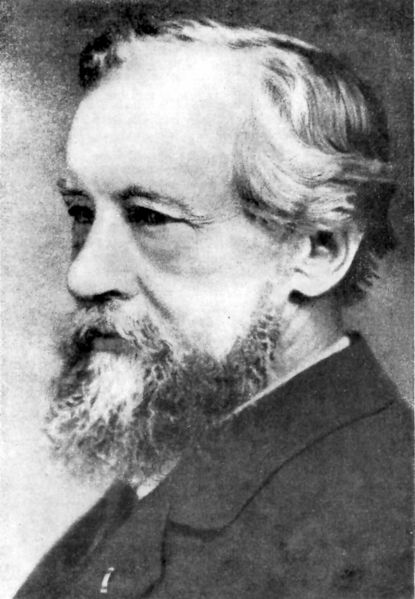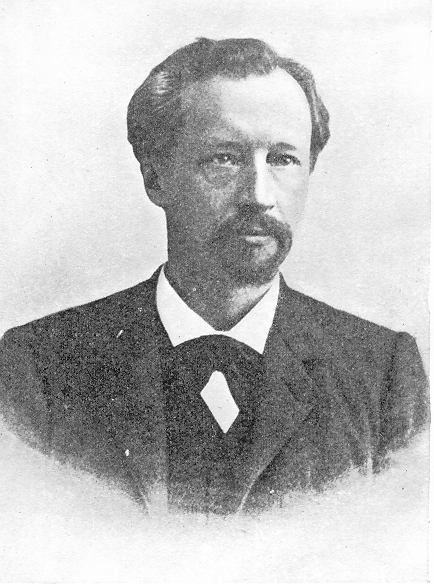<Back to Index>
- Botanist Hugo Marie de Vries, 1848
- Painter Arnold Boonen, 1669
- Emperor of the Song Dynasty Yingzong, 1032
PAGE SPONSOR


Hugo Marie de Vries (February 16, 1848, Haarlem – May 21, 1935, Lunteren) was a Dutch botanist and one of the first geneticists. He is known chiefly for suggesting the concept of genes, rediscovering the laws of heredity in the 1890s while unaware of Gregor Mendel's work, for introducing the term "mutation", and for developing a mutation theory of evolution.
De Vries was born in 1848, the oldest son of Gerrit de Vries (1818 – 1900), a lawyer and deacon in the Mennonite congregation in Haarlem and later Prime Minister of the Netherlands from 1872 until 1874, and Maria Everardina Reuvens (1823 – 1914), daughter of a professor in archaeology at Leiden University. His father became a member of the Dutch Council of State in 1862 and moved his family over to The Hague. From an early age Hugo showed much interest in botany, winning several prizes for his herbariums while attending gymnasium in Haarlem and The Hague.
In 1866 he enrolled at the Leiden University to major in botany. He enthusiastically took part in W.F.R. Suringar's classes and excursions, but was mostly drawn to the experimental botany outlined in Julius Sachs' 'Lehrbuch der Botanik' from 1868. He was also deeply impressed by Charles Darwin's
evolution theory, despite Suringar's skepticism. He wrote a
dissertation on the effect of heat on plant roots, including several
statements by Darwin to provoke his professor, and graduated in 1870. After a short period of teaching, De Vries left in September 1870 to take classes in chemistry and physics at the Heidelberg University and work in the laboratory of Wilhelm Hofmeister. In the second semester of that school year he joined the lab of the esteemed Julius Sachs in Würzburg to study plant growth. From September 1871 until 1875 he taught botany, zoology, and geology at schools in Amsterdam. During each vacation he returned to the lab in Heidelberg to continue his research. In 1875 the Prussian Ministry of Agriculture offered De Vries a position as professor at the still to be constructed Landwirtschaftliche Hochschule ("Royal Agricultural College") in Berlin.
In anticipation, he moved back to Würzburg, where he studied
agricultural crops and collaborated with Sachs. By 1877, Berlin's
College was still only a plan, and he briefly took up a position
teaching at the University of Halle - Wittenberg. The same year he was offered a position as lecturer in plant physiology at the newly founded University of Amsterdam. He was made adjunct professor in 1878 and full professor on his
birthday in 1881, partly to keep him from moving to the Berlin College,
which finally opened that year. De Vries was also professor and
director of Amsterdam's Botanical Institute and Garden from 1885 to 1918.
In 1889, De Vries published his book Intracellular Pangenesis, in which, based on a modified version of Charles Darwin's theory of Pangenesis of
1868, he postulated that different characters have different hereditary
carriers. He specifically postulated that inheritance of specific
traits in organisms comes in particles. He called these units pangenes, a term 20 years later to be shortened to genes by Wilhelm Johannsen. To
support his theory of pangenes, which was not widely noticed at the
time, De Vries conducted a series of experiments hybridising varieties
of multiple plant species in the 1890s. Unaware of Mendel's work, De
Vries used the laws of dominance and recessiveness, segregation, and independent assortment to explain the 3:1 ratio of phenotypes in the second generation. His observations also confirmed his hypothesis that inheritance of specific traits in organisms comes in particles. He
further speculated that genes could cross the species barrier, with the
same gene being responsible for hairiness in two different species of
flower. Although generally true in a sense (orthologous genes,
inherited from a common ancestor of both species, tend to stay
responsible for similar phenotypes), De Vries meant a physical cross
between species. This actually also happens, though very rarely in
higher organisms (horizontal gene transfer). In
the late 1890s, De Vries became aware of Mendel's obscure paper of
thirty years earlier and he altered some of his terminology to match.
When he published the results of his experiments in the French journal Comtes Rendus de l'Académie des Sciences in 1900, he neglected to mention Mendel's work, but after criticism by Carl Correns he conceded Mendel's priority. Correns and Erich von Tschermak now share credit for the rediscovery of Mendel’s laws. Correns was a student of Nägeli,
a renowned botanist with whom Mendel corresponded about his work with
peas but who failed to understand its significance, while,
coincidentally, Tschermak's grandfather taught Mendel botany during his
student days in Vienna. In his own time, De Vries was best known for his mutation theory. In 1886 he had discovered new forms among a display of the evening primrose (Oenothera lamarckiana)
growing wild in a meadow. Taking seeds from these, he found that they
produced many new varieties in his experimental gardens; he introduced
the term mutations for these suddenly appearing variations. In his two volume publication The Mutation Theory (1900 – 1903)
he postulated that evolution, especially the origin of species, might
occur more frequently with such large scale changes than via Darwinian
gradualism, basically suggesting a form of saltationism. De Vries's theory was one of the chief contenders for the explanation of how evolution worked, leading, for example, Thomas Hunt Morgan to study mutations in the fruit fly, until the modern evolutionary synthesis became
the dominant model in the 1930s. Somewhat ironically, the large scale
primrose variations turned out to be the result of chromosomal
duplications (polyploidy), while the term mutation now generally is restricted to discrete changes in the DNA sequence. Finally, in a published lecture of 1903 (Befruchtung und Bastardierung, Veit, Leipzig), De Vries was also the first to suggest the occurrence of recombinations between homologous chromosomes, now known as chromosomal crossovers, within a year after chromosomes were implicated in Mendelian inheritance by Walter Sutton.
In May 1905, De Vries was elected
Foreign Member of the Royal Society. In 1910, he was elected a member of the Royal Swedish Academy of Sciences. He was awarded the Darwin Medal in 1906 and the Linnean Medal in 1929. He retired in 1918 from the University of Amsterdam and withdrew to his estate "De Boeckhorst" in Lunteren where he had large experimental gardens. He continued his studies with new forms until his death in 1935.